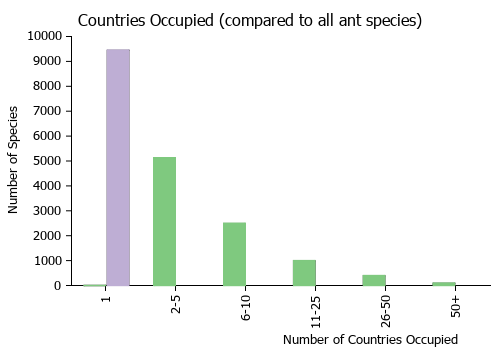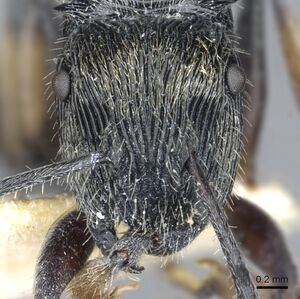Polyrhachis impressa
| Polyrhachis impressa | |
|---|---|

| |
| Scientific classification | |
| Kingdom: | Animalia |
| Phylum: | Arthropoda |
| Class: | Insecta |
| Order: | Hymenoptera |
| Family: | Formicidae |
| Subfamily: | Formicinae |
| Tribe: | Camponotini |
| Genus: | Polyrhachis |
| Subgenus: | Aulacomyrma |
| Species: | P. impressa |
| Binomial name | |
| Polyrhachis impressa Kohout, 2007 | |
Nothing is known about the biology of Polyrhachis impressa.
Identification
Kohout (2007) - P. impressa is very similar to Polyrhachis orokana. Both species share the laterally immarginate mesosomal dorsum, strong transverse ridge separating the propodeal dorsum from declivity and virtually identical sculpture of the mesosomal dorsum. They can be distinguished by the shape of the fused mesonotal-propodeal dorsum which is about as wide as long in impressa and is strongly transverse, distinctly wider than long in orokana. The eyes in impressa are only moderately convex and situated in a shallow depression in the cephalic sculpture, only partly extending beyond the lateral outline of the head in full face view. In contrast, the eyes in orokana are strongly convex, protuberant and in full face view they fully extend beyond the lateral cephalic outline. The antennal scapes in impressa bear numerous hairs over all their surfaces, while in orokana the hairs are confined to their leading edges. The petiole in impressa has the lateral spines relatively long and weakly bent backwards, while they are rather short and virtually straight in orokana.
Keys including this Species
Distribution
Distribution based on Regional Taxon Lists
Indo-Australian Region: New Guinea (type locality).
Distribution based on AntMaps
Distribution based on AntWeb specimens
Check data from AntWeb
Countries Occupied
| Number of countries occupied by this species based on AntWiki Regional Taxon Lists. In general, fewer countries occupied indicates a narrower range, while more countries indicates a more widespread species. |

|
Estimated Abundance
| Relative abundance based on number of AntMaps records per species (this species within the purple bar). Fewer records (to the left) indicates a less abundant/encountered species while more records (to the right) indicates more abundant/encountered species. |

|
Biology
|
Castes
Males have yet to be collected.
Images from AntWeb

| |
| Worker. Specimen code casent0009240. Photographer April Nobile, uploaded by California Academy of Sciences. | Owned by MCZ, Cambridge, MA, USA. |
   
| |
| Paratype of Polyrhachis impressa. Worker. Specimen code casent0903318. Photographer Z. Lieberman, uploaded by California Academy of Sciences. | Owned by NHMUK, London, UK. |
Nomenclature
The following information is derived from Barry Bolton's Online Catalogue of the Ants of the World.
- impressa. Polyrhachis (Aulacomyrma) impressa Kohout, 2007a: 224, figs. 73, 76, 79 (w.q.) NEW GUINEA.
Unless otherwise noted the text for the remainder of this section is reported from the publication that includes the original description.
Description
Worker
TL c.5.09-5.69 (5.19); HL 1.31-1.47 (1.34); HW 1.12-1.28 (1.12); CI 83-89 (83); SL 1.34-1.47 (1.34); SI 120-122 (120); PW 0.94-1.09 (0.94); MTL 11.25-1.34 (1.28) (12 measured).
Anterior clypeal margin arcuate, narrowly truncate medially; basal clypeal margin flat, indicated only by hairline break in cephalic sculpture. Frontal triangle indistinct. Frontal carinae relatively short, strongly raised. Sides of head in front of eyes weakly converging towards mandibular bases; strongly rounded behind into rather short preoccipital margin. Eyes convex, somewhat sunk into shallow concavity in cephalic sculpture on sides of head; in full face view only moderately extending beyond lateral cephalic outline. Mesosoma laterally immarginate with dorsum rounding onto sides in unbroken curve. Pronotal humeri armed with short, acute spines. Promesonotal suture deeply impressed; metanotal groove lacking. Propodeal dorsum delimited posteriorly by distinct transverse ridge that separates dorsum from declivity, posterolaterally with minute, somewhat dorsally raised, rounded prominences. Petiole with sharp dorsal margin; lateral spines acute, weakly curved backwards and upwards. First gastral segment shallowly concave anteriorly, anterodorsal margin of concavity blunt.
Sculpture of head and mesosoma mostly consisting of regularly spaced striae; longitudinal on sides of head, converging anteriorly on clypeus and vertex; somewhat inversely U-shaped on pronotal dorsum and obliquely rounding onto sides. Striae on mesosomal and propodeal dorsa forming incomplete semicircles, outermost striae continued obliquely on sides of propodeum. Both faces of petiole shagreened. First gastral segment with dorsum finely striate; intensity of sculpture increasing laterally with sides of gaster very distinctly longitudinally striate.
Relatively short, off-white and yellowish hairs scattered over all dorsal surfaces of head, mesosoma and gaster; hairs silvery and distinctly shorter along dorsal and lateral borders of propodeal declivity and dorsal margin of petiole. Off-white or silvery appressed pubescence, generally directed towards midline, present over all dorsal surfaces of body; most dense on pronotal humeri and dorsum and sides of propodeum. Gastral pubescence golden, rather dense, almost completely obscuring underlying sculpture dorsally.
Body black. Antennae, femora, proximal ends of tibiae and basal tarsal segments black or very dark brown; extreme tip of apical funicular segment, distal end of trochanters, tibiae and apical tarsal segments medium to light yellowish to reddish brown.
Queen
TL c. 6.20; HL 1.56; HW 1.31; CI 84; SL 1.53; SI 117; PW 1.25; MTL 150 (1 measured).
Queen essentially as worker, with usual characters identifying full sexuality, including three ocelli and complete thoracic structure with wings. Sculpture of head and body similar to worker, direction of striae following structural characteristics of fully developed mesosoma.
Type Material
HOLOTYPE: PAPUA NEW GUINEA, Huon Pen., lower Busu R., 10.v.1955, lowl. rf., E. O. Wilson #1003 (worker). PARATYPES: data as for holotype, but 27.iv.1955, E. O. Wilson #706 (worker); 10.v.1955, E. O. Wilson #988 (2 workers); 12.v.1955, E. O. Wilson #1018 (worker) and 17.v.1955, E. O. Wilson #1054 (7 workers, 1 dealate queen). Type distribution: holotype, 1 paratype worker and paratype queen in Museum of Comparative Zoology; 2 paratype workers each in Australian National Insect Collection, The Natural History Museum, California Academy of Sciences and Queensland Museum.
Etymology
The name impressa is derived from a self-explanatory term ‘impressive’ relating to the rather striking appearance of this species.
References
References based on Global Ant Biodiversity Informatics
- Janda M., G. D. Alpert, M. L. Borowiec, E. P. Economo, P. Klimes, E. Sarnat, and S. O. Shattuck. 2011. Cheklist of ants described and recorded from New Guinea and associated islands. Available on http://www.newguineants.org/. Accessed on 24th Feb. 2011.
- Kohout R.J. 2007. Revision of the subgenus Aulacomyrma Emery of the genus Polyrhachis F. Smith, with descriptions of new species (pp. 186-253). In Snelling, R.R., Fisher, B.L. & Ward, P.S. (eds). Advances in ant systematics: homage to E.O. Wilson 50 years of contributions. Memoirs of the American Entomological Institute 80: 690 pp.

